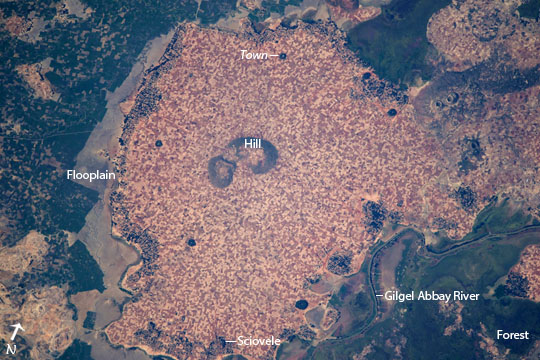
 Photo #: ISS050-E-30105 Date: Jan. 2017
Photo #: ISS050-E-30105 Date: Jan. 2017Geographic Region: ETHIOPIA
Feature: GILGEL ABAY R., AGR., SCIOVELE, MIRAB GOJJAM, AMHARA REGION

 Photo #: ISS050-E-30105 Date: Jan. 2017 Photo #: ISS050-E-30105 Date: Jan. 2017Geographic Region: ETHIOPIA Feature: GILGEL ABAY R., AGR., SCIOVELE, MIRAB GOJJAM, AMHARA REGION |
 |
| Image Caption: Agriculture on the High Ethiopian Plateau An astronaut aboard the International Space Station centered this photograph on numerous, densely packed agricultural fields that occupy all the higher ground in the center of the picture--a region ~8 km in diameter. Taken at the end of the dry season, the photograph shows fallow rain-fed fields (brown and tan colored)--except around the margins of the region where forested villages have access to river water (the largest village is Sciovele at image lower margin). Thin river channels are associated with long floodplains (at image left and lower right) that arc around the tan fields. These floodplains are part of wide lower-lying wetlands that support both swamp vegetation and another set of fields where crops still thrive despite the dry season. Agriculture in the lower wetlands takes advantage of what is known as flood-recession agriculture where wet-season rainwater drains more slowly and is available for plant growth even in the middle of the dry season (the wetlands are part of a complex coastal zone of Lake Tana, which lies just outside the top of the image). Individual fields and angular margins at the floodplain visible at image left are indicative of this human use and modification of the wetlands. The Gilgel Abbay River (at image lower right) is lined with very narrow fields that give the greatest number of farmers access to water. Forests occupy parts of the wetlands but also places on higher ground such as the hill in the center of the image, and five minuscule circular patches of forest that are dispersed among the fields. These surround monasteries that are characteristic of the region. The relatively high rainfall in the Ethiopian Highlands makes the region suitable for growing coffee, oilseeds, and grains, especially subsistence crops such as wheat and sorghum. However, the recent years-long drought set off by an El Nino event is threatening Ethiopia's food supply. The United States and the Ethiopian Governments are planning for the need to support as many as 9.7 million people who will face food shortages. |
| Images: | All Available Images Low-Resolution 116k |
|
| Mission: | ISS050 |
|
| Roll - Frame: | E - 30105 |
|
| Geographical Name: | ETHIOPIA |
|
| Features: | GILGEL ABAY R., AGR., SCIOVELE, MIRAB GOJJAM, AMHARA REGION |
|
| Center Lat x Lon: | 11.7N x 37.1E |
|
| Film Exposure: | N=Normal exposure, U=Under exposed, O=Over exposed, F=out of Focus |
|
| Percentage of Cloud Cover-CLDP: | 10 |
|
| Camera:: | N6 |
|
| Camera Tilt: | 30 | LO=Low Oblique, HO=High Oblique, NV=Near Vertical |
| Camera Focal Length: | 1150 |
|
| Nadir to Photo Center Direction: | NW | The direction from the nadir to the center point, N=North, S=South, E=East, W=West |
| Stereo?: | Y=Yes there is an adjacent picture of the same area, N=No there isn't |
|
| Orbit Number: | |
|
| Date: | 20170102 | YYYYMMDD |
| Time: | 114221 | GMT HHMMSS |
| Nadir Lat: | 10.0N |
Latitude of suborbital point of spacecraft |
| Nadir Lon: | 38.4E |
Longitude of suborbital point of spacecraft |
| Sun Azimuth: | 224 | Clockwise angle in degrees from north to the sun measured at the nadir point |
| Space Craft Altitude: | 220 | nautical miles |
| Sun Elevation: | 44 | Angle in degrees between the horizon and the sun, measured at the nadir point |
| Land Views: | |
|
| Water Views: | |
|
| Atmosphere Views: | |
|
| Man Made Views: | |
|
| City Views: | |
|
Photo is not associated with any sequences | ||
| NASA Home Page |
JSC Home Page |
JSC Digital Image Collection |
Earth Science & Remote Sensing |
|
|